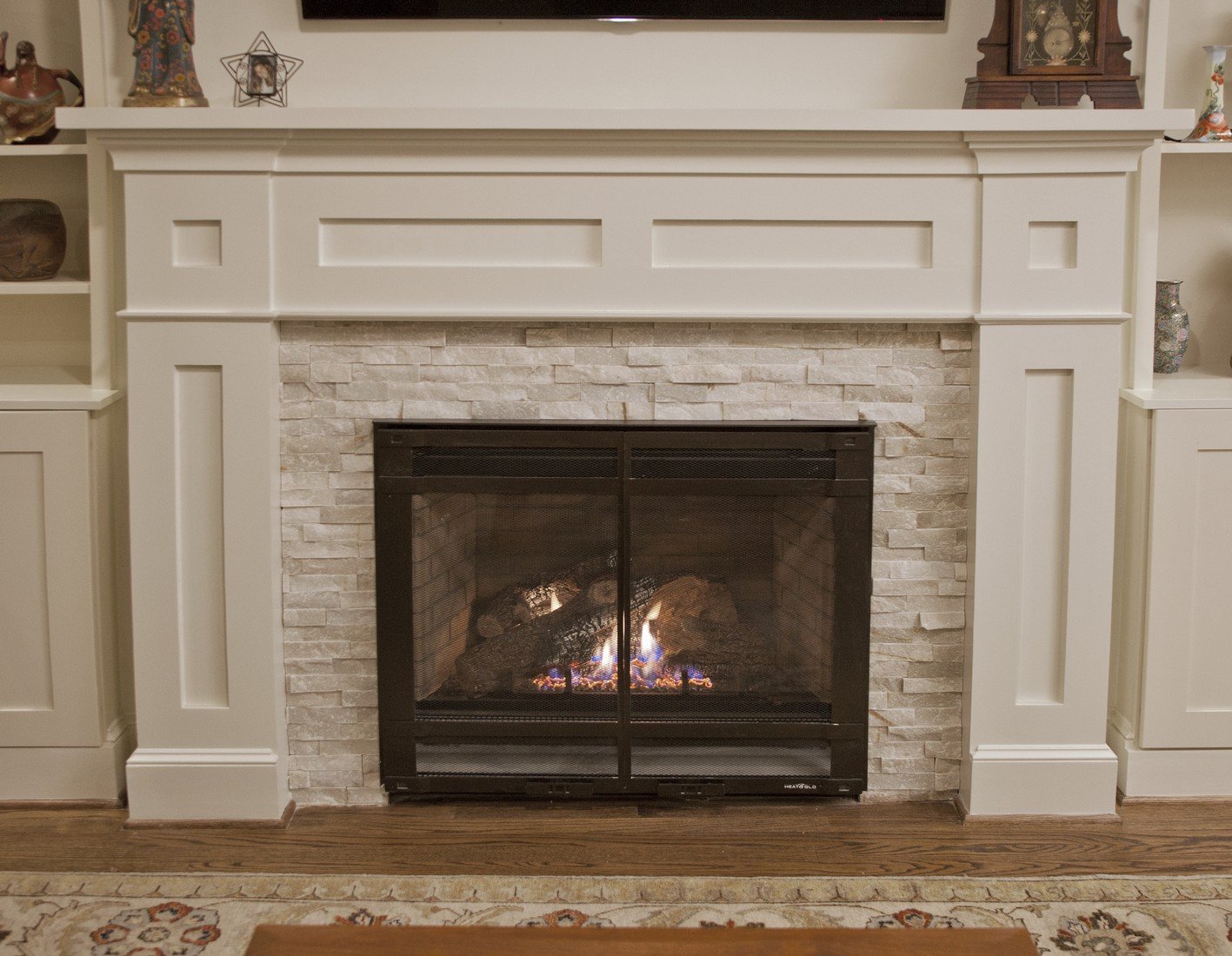
If you’ve looked into vent-free fireplaces at all, you’ve probably discovered there are quite a few differing opinions on the safety of installing one in your home. The basic concept of a vent-free fireplace is easy enough to understand. By burning gas instead of wood, you can create a “smokeless” heat that doesn’t require ventilation and allows all the heat created by the fire to stay in your home. Of course, it’s not exactly that simple. By-products are still created when burning gas in your home, including carbon dioxide, carbon monoxide, sulfur dioxide, among others. These gases get pushed into your home along with the heat, which can create a dangerous situation if not carefully monitored.
Vent-Free Fireplaces and Other Appliances
You might be thinking if all these dangerous gases are being pushed into my home, how is it that vent-free fireplaces are safe at all for residential use? It’s a good question and some people would say they’re not. Others will point out that you’re also openly burning gas when you turn on your stove, and people aren’t exactly showing up in the news condemning the use of gas stove and oven ranges.
Both points of view are valid and misleading. If you have a high capacity oven range, ran all the burners on high for several hours a day (or if it’s malfunctioning), you might have a toxic gas problem. On the other hand, if you properly size a vent-free fireplace and only run it on a limited basis and well within the manufacturer’s specifications, you shouldn’t have any problems with dangerous gases. That said, many homeowners take the stance that no level of dangerous gases are safe in their home.
Carbon Monoxide and Other Dangerous Gases
Of all the dangerous gases, carbon monoxide is the most dangerous and the most notorious. Few homeowners are still unaware of the odorless and colorless gas. It can cause all sorts of health problems ranging from mild headaches to death. If you decide to install a vent-free gas fireplace do yourself favor and install multiple carbon monoxide detectors in your home, including near the fireplace. Check them regularly.
One of the less advertised gases that can be dangerous to your home is water vapor. Excessive water vapor being emitted from your vent-free gas fireplace can cause your wallpaper to peel, as well as other structural damage. Even gases other than carbon monoxide can cause respiratory problems if they’re present in large enough quantities and/or someone in the home has sensitivity to that gas.
Ready to start your ventless fireplace?
Find ProsHomeowner Safety and Fireplace Alternatives
Improper installation, improper fireplace sizing, improper use, and appliance failure can all lead to major safety issues. In fact, health concerns over the use of this appliance have led some countries and states within the US to ban vent-free gas fireplaces. Still, too many homeowners covet the low installation and operating cost and only want to use their fireplace on a limited basis. If you’re one of these homeowners, at the very least try to find a contractor/manufacturer who will bear the responsibility for product failure, should something go wrong. Ask these professionals and companies about health concerns. If they dismiss these concerns as foolish myths, you should probably run for the door. On the other hand, if they tell you there are some concerns, but they’ve never had any problems with their fireplaces, ask them to put in writing that they will cover any damages and expenses associated with product failure.
Your best bet remains to simply put up the extra money and install a vented fireplace. It may cost a little more and not be as energy-efficient, but saving a few dollars on your utility bill shouldn’t be as important as the health and safety of your household.
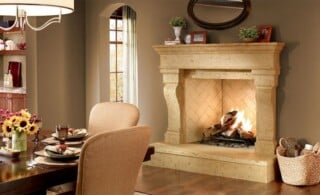 Turn Your Fireplace into a Work of Art with a Fireplace Surround
Turn Your Fireplace into a Work of Art with a Fireplace Surround 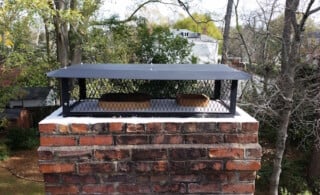 Preventive Maintenance: Chimneys
Preventive Maintenance: Chimneys 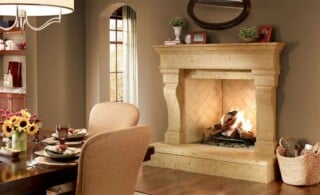 Chimney Bombs
Chimney Bombs 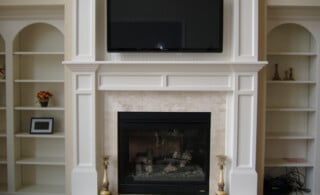 Stoking the Fire: Fireplace Remodels
Stoking the Fire: Fireplace Remodels 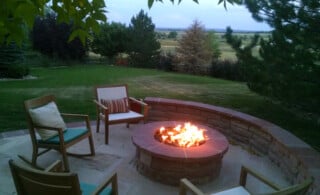 Enjoy Summer Nights with an Outdoor Fire Pit
Enjoy Summer Nights with an Outdoor Fire Pit 

re: ventless fireplace inserts.
I have an existing fireplace that i want to convert to an insert. I would like a ventless but have read about the dangers of carbon monoxide etc. would there be an advantage of maybe leaving damper open a little to eliminate the gas leaking into room or should I not worry about it and close dampers fully.
Thanks
I used my ventless fireplace a lot, I loved it so much.
But without noticing, I was getting headaches, and listlessness, and finally developed daily debilitating Cluster headaches that damaged my left eye. Diagnosed a year later with Horners Syndrome.
Haven’t used the fireplace since. Be careful what you wish for. It costed over $4,000 to install and purchase. 🙁
I know I have a U.K. email address but I actually live in the USA. We are having a ventless gas fireplace inserted and after reading the dangers that can occur we have now opened up our chimney. The chimney is over 100 years old and built to house a coal fire so it is quite narrow.
Even though it is narrow will this make it safe to have the ventless fireplace installed or should we put doors on the front as well.
Any advice is very much appreciated. Thank you. Melanie
How to vent a ventless gas fireplace
I have heated my 2500sf victorian in carson city nevada for over 15yrs using only 5 ventless gas logs/stoves. It’s dry in Nevada in winter so the moisture they put into room feels good and doesn’t condense on the single pane glass after i put in storm windows. My CO detectors have NEVER measured ANY CO. If the flame is allowed to touch something like a fake log, this can cause a tiny amount of white soot to expell- not sure if this is a health concern or not but we love heating this way.
My ventless fireplace has put black suit all over the ceiling and furniture! Does this mean that we are breathing In this suit? Cleaned the room yesterday and everything was covered with black dust! I
Am concerned because of previous cancer and we use this fireplace a lot due to the cold cold weather!
Can a gas fireplace be used on an inside wall or does it need a chimney type setup
Is it okay to cap off a flume when installing vent less logs? Do you still need ventilation
Sarah Elliott.
There’s basically 4 reasons a vent-free gas fireplace will produce soot like you described.
1. The unit hasn’t been serviced annually since you purchased it.
Vent-fee gas logs are not maintenance free. They must be inspected & cleaned
annually by a professional gas technician.
2. The log(s) are out of place and are impinging the flames.
This is one of the most common problems. Check your Owners Manual for the proper
placement.
3. You’re running a ceiling fan in the wrong direction and/or at to high a speed.
Using a ceiling fan to help distribute the heat works well. But, the blades of the fan
should be set to turn counter clock (as you’re looking up at the fan) and set on slowest
speed.
4. You’re burning scented candles while the burner is in operation.
Scented candles soot any way. When you add the warm, moist heat from the Vent-free
Gas Log Set. They’ll soot 50 times worse.
Mel Arnott
I know this is a little late. But, what you’re doing is creating a Vented gas fireplace. If you only want the ambience of a fire and not interested in the heating capability. That’s what you have created.
Larry ray.
It’s not necessary to cap of the “flue” unless you want to. Having a screened Chimney Cap to keep the birds and squirrels out is a better idea. Closing the damper is all you need to do.
Mel Arnott
One more thing Melanie . Glass doors and Vent-free gas log sets don’t work well together. Even if you leave them open while the log set is in operation. A freestanding trifold hearth screen works well. The firebox opening should remain just that … Open.
Moe Hufsey.
Yes. If you’re installing a Vent-free Gas Fireplace. Make sure that the maximum BTU Output is not more than you need or can handle.
To ALL.
Vent-free gas log sets and fireplaces are totally safe. Despite what some dealers and websites will tell you. They just want to sell you something that’s more expensive and inefficient. The Dept of Energy rates a Vented Log Set or Fireplace as Decorative Gas Appliance. Vent-free is rated as a Decorative Supplemental Gas Heating Appliance.
I have been in the gas fireplace business for almost 20 years and have found that 95% of the problems customers complain about are due to operator error. The rest are normally covered by the manufacturer’s warrant.
My best advice is make your purchase from a brick and mortar hearth dealer. One that will come to your home and survey what you want to do. Check their Customer Comments & Reviews about their work and knowledge. Different states have different Codes. It’s not one size fits all.
And finally, Don’t buy online or from a Big Box Store, just because the price is cheaper. 9 times out of 10 you’re buying a piece of junk that has a very limited warranty and is only a seasonal product for them.Plus, who’s going to install it properly for you?
Vent-free gas heating appliances do require annual service. Not doing this will cause problems down the road, that you don’t want to have to deal with.
Also, keep in mind there are two types of Vent-free Gas Log Sets and Fireplaces. Ones for Natural Gas and the other for Propane Gas. They can not be converted from one gas type to the other. In addition there are 2 types of logs. Ceramic Fiber and Refractory Concrete.
Ceramic Fiber feels like a piece of Styrofoam when you pick one up and do not last long when burning Propane.
Refractory Concrete are just that. A Molded Refractory Concrete Log is fired under high heat and will last forever on either Natural Gas or Propane.
Hope all of this helps you make the right decision.
We bought a home in Evans, GA in 2010. Our fireplace was ventless gas. But, 2 years ago 2016), our son, who is a builder (in a diiferent state), spent the night. We had the fireplace on as we had morning coffee. Our son got up an hour later and told us to turn it off. He had a meter to measure the carbon monoxide levels (and yes we have 3 that came with the NEW house but they didn’t go off.) Anyway, his registered dangerous levels. So, we had it completely disconnected Now we have an electric fireplace. Love it and I don’t have to worry about dying in my sleep. Why are ventless fireplaces not banned?
I have had a ventless fireplace for 22 years. The last 4 years I used it all winter instead of my furnace. Cost me a lot less. I never had any problems. No soot, I have wall paper in the room the fireplace is in and the rest of the house for 39 years. It is still up with no problems. I love mine.
We recently put in 2 ventless fireplaces for propane. When we burn them the smell is very strong. We can’t burn them very long without having to turn the off, it stinks!
Will this smell eventually burn off?
I would have never installed them if I would have know about the odor .
Installed ventless fireplace. Ran overnight in a 200sf home, with vaulted ceilings and carbon dioxide detectors. Next morning woke up disoriented and confused. Unusual odor in home. No alarm. Staggered to outside. After several minutes of fresh air almost fully recovered. Went back inside , immediately shut off stove, opened windows and doors.
Never turned on stove again and would not consider recommending one to any person unless an enemy.
Previous post saying they are safe, without venting, is either dishonest, salesman , manufacturer, or a complete fool.
We used our ventless fireplace quite often when we first moved in. It did give me headaches when it was first fired up every year but once the dust burned off it was okay. I recently had a baby and am not sure about using it this winter. Not sure if its safe for kids.
Do ceramic logs in ventless gas fireplace give off a dangerous or toxic gas when burned?
While burning propane ventless fireplace, is it wise to keep a window open? Does that help against CM poisoning?
Just over 2 years ago, I bought a home with a ventless fireplace insert fueled by propane. I did some research on the ventless/vented debate and decided to place temp/humidistats throughout the home. I also have hardwired CO alarms on each floor. Obviously humidity and combustion products are the concern. I have a split Cape and, right now (12/26/18), the first floor is at 34% humidity and the upstairs is 40%. In addition to having had the unit cleaned each year, my unit has a fresh air vent and I make sure it’s open. I’m extremely pleased with my ventless because there’s adequate ventilation and it’s properly set-up and maintained. Why settle for 80% efficiency when you can have 99%? Part of the debate against ventless is, clearly, that builders, heater dealers, etc make more money selling vented systems. Just read their support quotes from entities like Chimney Sweeps (who don’t have a business with ventless) and you’ll see the lack of objectivity. But it has to be set-up and maintained correctly.
We installed ventless in our condo when we first moved to Tn. As a backup heat source in case of power outage from ice storms. When we had the first storm and lost power for 5 days they became our God send. We were the only ones with heat. Everyone else had to leave but we remained warm and cozy. Just make sure you watch the cubic foot requirements of you fireplace and install detectors. Cracking a window helps keep the air fresh and sufficient Oxygen.
We installed ventless in our condo when we first moved to Tn. As a backup heat source in case of power outage from ice storms. When we had the first storm and lost power for 5 days they became our God send. We were the only ones with heat. Everyone else had to leave but we remained warm and cozy. Just make sure you watch the cubic foot requirements of you fireplace and install detectors. Cracking a window helps keep the air fresh and sufficient Oxygen.
We have had our ventless for 6 months. We have it on all day, I turn it down at night and allow the electric furnace low heat while sleeping. The stove is properly sized with the correct gas pressure regulator installed. We have none of the issues I am reading about. I think the two things proper size and gas pressure are important and should be stressed. The stove will not burn correctly if the pressure of the supply gas is not set at what the stove is rated at. If your stove is the wrong size for the area to be heated you will have problems. Our stove is burning about the same amount of time it is off. We do have two detectors, one in the same room as the stove and one in the hallway to the three bedrooms.
Another great option people are not considering is an ethanol fireplace. Much bigger in Europe modernethanolfireplaces.com/blogs/news/ethanol-fireplace-ultimate-buyers-guide
I don’t get why people with a bad experience want to ban vent free propane fireplaces. I have had no issue with mine. It’s like any piece of technology, including a car: if you don’t know what you are doing, it can kill you. But just because you don’t want to take the time to learn, why do you want to mess it up for everyone else?
We have been in the Fireplace business for about 30 years. We have tore out & replaced 100’s & 100’s of ventfree Fireplaces ,logs & inserts over the years & replaced them with directvent gas products. The truth really is there is, no such thing as a ventfree , only the name. All ventfree products explains plainly in there installer manuals & owners manual. You must provide proper combustion & ventilation air. So how does that work ? There is no vent . The truth is when you install a ventfree you live in your chimney,flue or vent which ever you would like to call it. Ventfree products should not be used as a main heat source. Many ventfree products are way over sized for the room there in. no one shares that info much. You should do your research. if you talking to some dealer are hearth professional & they tell you they never have problem are heard of any problems with there ventfree product they sell . Its probably not the truth unless there customer doens’t turn it on. We get calls just about everyday in burn season with consumers complaining about there ventfree Fireplace ,Log or insert. one big problem many of them have no idea they have one. just purchased a home & the product was there. Really scary they don’t know how the product should be used or mostly not used. We get really tired of telling the story doing our best to try & help consumers get the truth & facts. There is just so much bad info out there. We post pictures all over of before & after showing soot all over homes. white contaminates every where. People still get mislead . We will continue this fight to try & make as many as we can aware. We could do like everyone else & just sell the junk but our customers are more important to us than the money. I would never put a ventfree in my house so we will never sell a ventfree. Do you research mostly use common sense. Think about it NO VENT. Why do you need ventilation air for something not vented & how does that work?
We have a big ventless that was here when we bought our condo. I crank a window open and have a fan blowing out, whenever I use it. I never use it for more than 2 or 3 hours at a time and have never had a problem. I wouldn’t use it EVER, without having some kind of ventilation going on in the living room where it is located. Until we can afford a vented gas unit, I’m fine with it. Just do be careful, all!
DO NOT install a ventless gas heater, mold,mold and more mold, I purchased a dehumidifier and collected almost a Gallon if water a day.
Vent-free gas products have been around for decades. This is not a new concept. Wall mount infrared and blue flame propage/NG heaters are common examples. They have been manufactured by nearly all heater companies at one point or another.
So, when you read comments from “professionals” who don’t understand how a vent-free gas wall heater could possibly work without “venting” do yourself a favor and disregard their comment and don’t hire them.
Vent-free heaters are primarily designed as supplemental “space” heaters, intended to be used intermittently. When used in this manner they are indeed, safe. Problems arise under the following circumstances:
1. Incorrect installation.
2. Incorrect application.
3. Lack of maintenace/improper maintenance.
4. Defective product.
Number four almost never happens. Number two almost always happens, followed by number one. Number three is important, but seldom the cause of a major problem. Instead, improper maintenance usually affects reliability, such as ease of starting, proper burn and results in fluttering, sputtering and weak or no pilot if regulators, flame sensors, oxygen depletion sensors are not inspected, cleaned or replaced as necessary.
The real truth is most folks simply use vent free heaters, logs, etc. improperly. Usually, the unit is too big for the intended space which then can affect air quality. This raises carbon monoxide levels and results in the heater getting blamed for the user’s error after they experience headaches, amnesia, tooth decay, arthritis or anything else besides the true issue at hand — incorrect application/user error.
Incorrect installation usually means the user did not install per manufacturer’s instructions. I’ll leave it at that. This is seldom an issue if installed properly by a competent professional. Some DIY’ers really mess this part up.
In summary, vent free heating products have been around a long time and are suitable heating solutions when installed, applied and maintained in the manner for which they are intended. Pretty simple, really. But, if a user cannot/will not respect these principles then they should just run their furnace and call it a day. This would serve others better than going online to write comments about how terrible, dangerous, ugly, racist or stupid their vent free heating product is.
To summarize, when it comes time to deciding whether a vent free gas fireplace is the best option for your home or project, it s always best to check with a fireplace professional. They can look at the room size, heating requirements, structural envelope of your home, competing combustion air appliances you may have, and other factors to help you make a decision on whether a vent free gas fireplace is the best solution for you.
If a log in a non-vented fireplace gets moved just enough so that the yellow flame licks it then soot is produced. CO also. If the kids or an uninformed adult pokes at the logs you will have a problem.
I just looked at a house that has a non-vented fireplace. The home owner disclosure indicated they had mishap several years ago. Soot all over the entire house. 40k$ damage. All walls and ceilings had to be repainted. Floors had to be scrubbed. Curtains, draperies replaced. Furniture scrubbed. Clothes discarded. On and on. They fixed everything. Then we saw the recent photos the real estate agent just published. And there was soot damage on the mantel and the wall above the fire place. So apparently it had happened again. Though not bad enough to require anything more than to clean up the immediate area.
If you have a non-vented fireplace, either install a chimney or change it into a fake electric. Regulations from California, Massachusetts, and Canada are often exaggerated, and over blown. But I ‘ll have to agree with them when it comes to non-vented fireplaces.